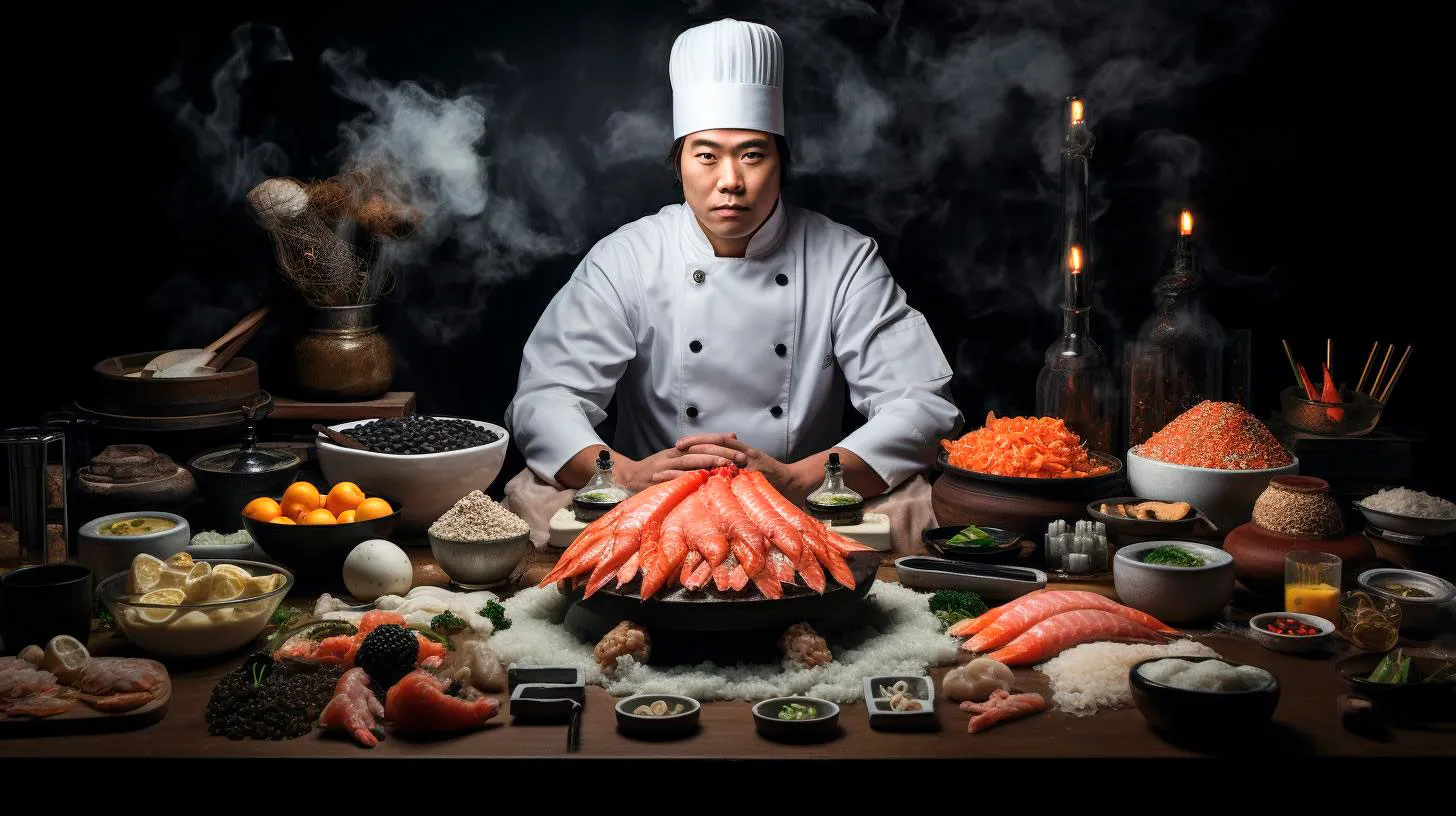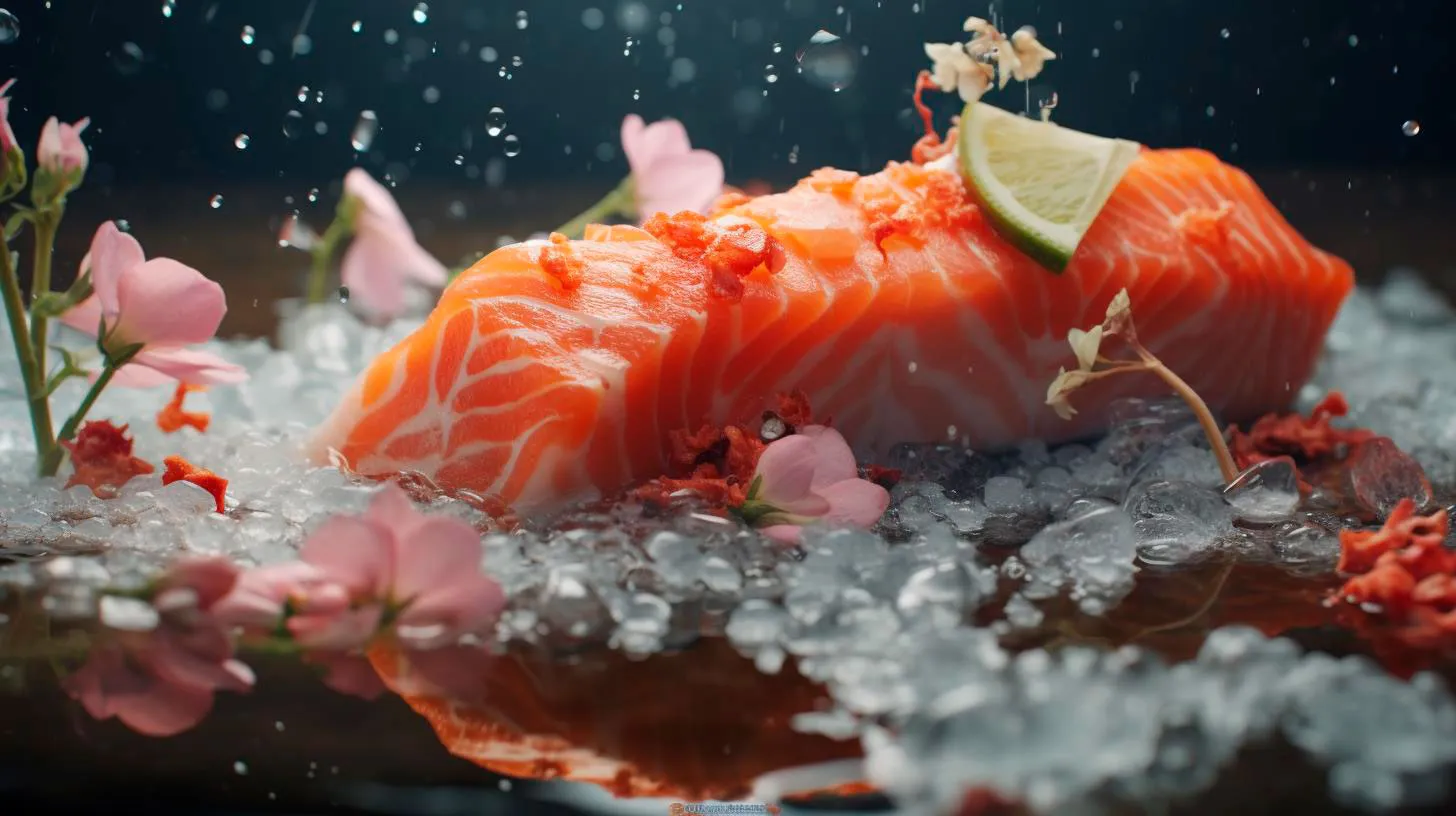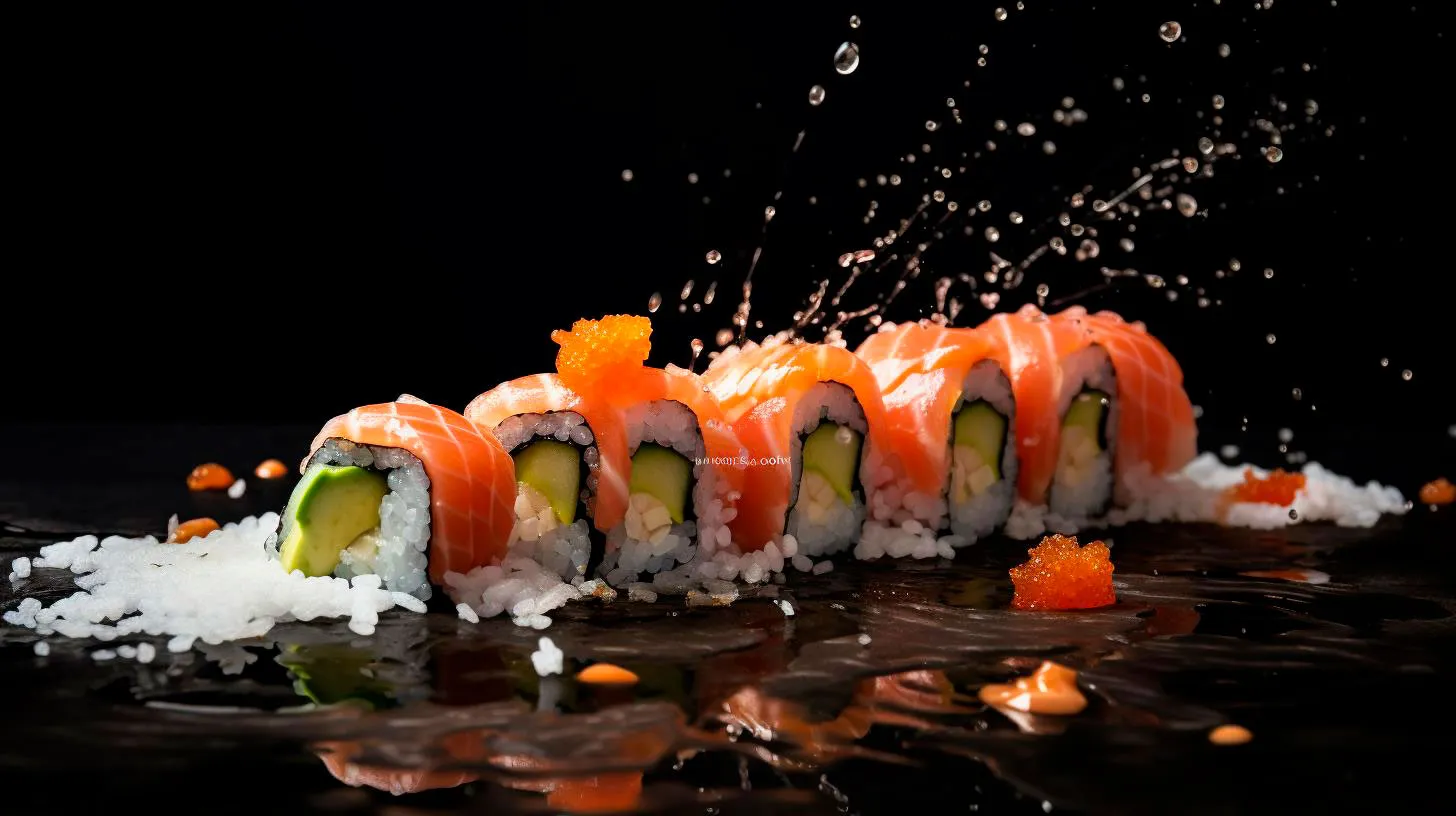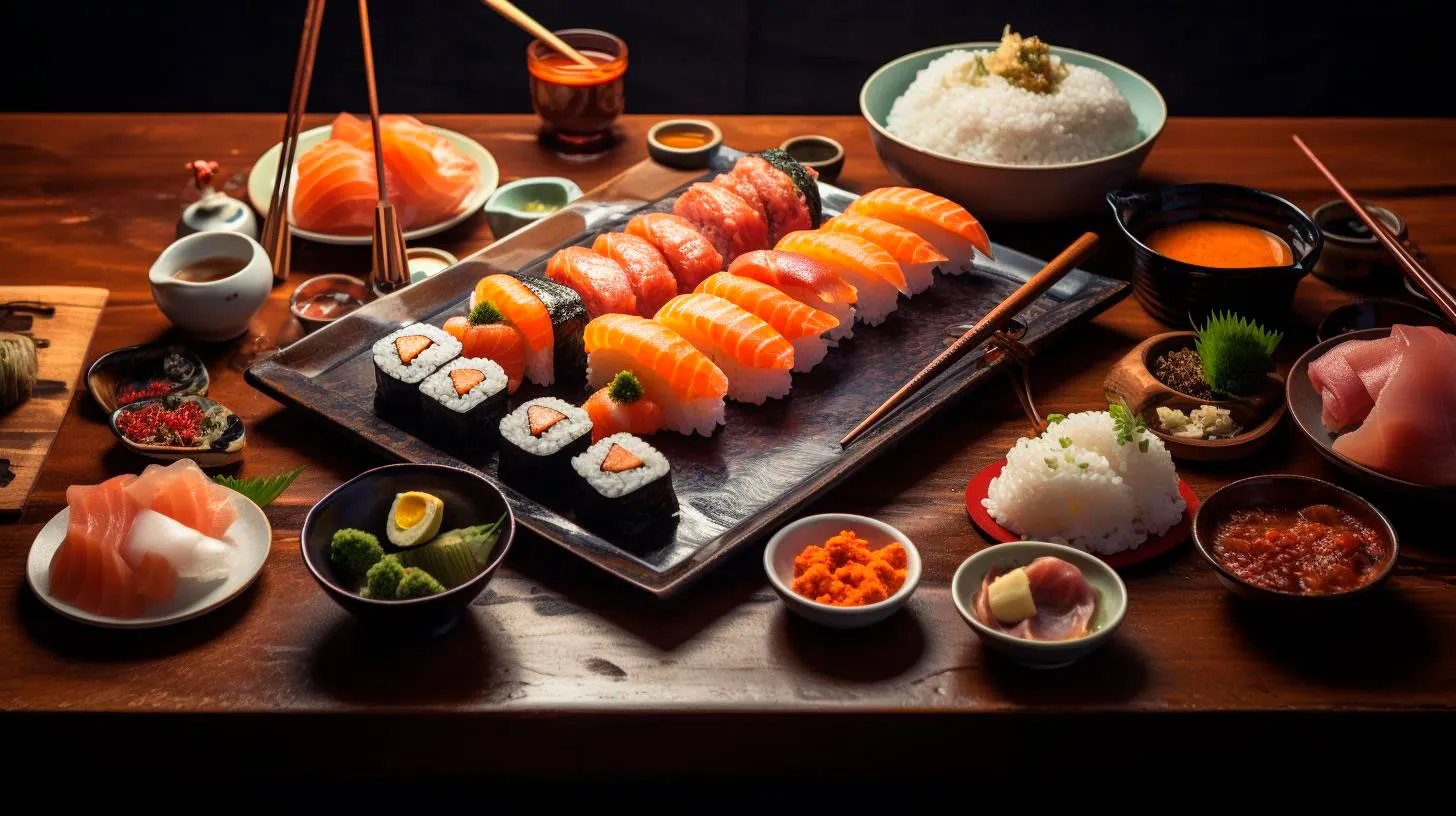Breaking Barriers: Exploring Diverse Cuisines Reflected in Sushi Artistry
In this article, we will delve into the world of sushi artistry and explore how it has broken barriers by incorporating flavors and ingredients from various cuisines. From fusion rolls to creative interpretations, sushi chefs have embraced diversity to create a whole new culinary experience.
The Rise of Fusion Rolls
Traditional sushi usually consists of fresh fish or seafood, vinegared rice, and seaweed. However, as sushi gained popularity worldwide, chefs started experimenting with different ingredients and flavors. The result? Fusion rolls that combine traditional elements with unique twists.
Advantages of fusion rolls:
- Expanded flavor profiles: By incorporating ingredients from different cuisines, fusion rolls offer a wide range of taste experiences.
- Appealing to diverse palates: Fusion rolls attract individuals who may not typically enjoy traditional sushi, catering to a broader audience.
- Opportunity for creativity: Chefs can showcase their creativity by blending flavors and textures, resulting in visually stunning and tasty rolls.
Fusion rolls have become a hit among sushi enthusiasts, bridging the gap between traditional and modern cuisine. Examples include the California Roll, which features avocado and crab, and the Spicy Tuna Roll, which adds a spicy kick to the classic sushi roll.
Global Ingredients, Local Interpretations
With sushi’s growing popularity, chefs all over the world have taken inspiration from their local cuisines to create unique sushi interpretations. By incorporating local ingredients and flavors, they have added an exciting twist to this traditional Japanese dish.
Key takeaways:
- Cultural adaptations: Sushi can evolve to reflect the local tastes and preferences of different regions, creating a cultural fusion.
- Utilization of regional ingredients: Chefs embrace local produce, seafood, and spices, introducing new flavors and textures to sushi.
- Preservation of traditional techniques: Despite the creative interpretations, sushi chefs keep the traditional sushi-making methods intact, maintaining authenticity.
For instance, in Brazil, sushi filled with tropical fruits such as mango and passion fruit is popular, delivering a sweet and tangy flavor. In Hawaii, the Spam Musubi roll blends the island’s love for Spam with Japanese rice and seaweed. These adaptations showcase how sushi has become a canvas for culinary experimentation across the globe.
Health-Conscious Sushi Trends
Sushi has also been influenced by the growing demand for healthy dining options. To cater to health-conscious individuals, sushi chefs have developed innovative variations that focus on nutrition without compromising on taste.
Benefits of health-conscious sushi:
- Increased nutritional value: Ingredients like quinoa, brown rice, and fresh vegetables enhance the health benefits of sushi.
- Lower calorie options: Health-conscious rolls often use lighter ingredients and reduced amounts of high-calorie condiments.
- Improved sustainability: Sustainable seafood choices are gaining prominence in the sushi industry, promoting responsible fishing practices.
Health-conscious sushi rolls, such as those made with cucumber instead of rice or wrapped in lettuce leaves, offer a lighter alternative. Additionally, sushi bowls, where the ingredients are arranged in a bowl rather than wrapped in seaweed, are gaining popularity among wellness enthusiasts.
The Future of Sushi Artistry
Sushi artistry continues to evolve, pushing boundaries and setting new culinary trends. As diverse flavors and techniques are integrated into this traditional cuisine, the possibilities are endless.
Industry statistics:
- In the United States alone, the sushi market is estimated to reach $22.5 billion by 2025, indicating the growing demand for sushi and its potential for further innovation.
- Sushi artistry has sparked the interest of numerous food bloggers and influencers, leading to a surge in online content and social media engagement.
- Artistic sushi presentations have become a favorite subject for food photographers, creating visually captivating images and enhancing the overall dining experience.
As sushi artistry gains momentum, we can expect to see more inventive combinations, unexpected flavors, and exciting interpretations. From sushi burritos to dessert sushi, the future of sushi promises to be an exhilarating journey.
In conclusion, sushi’s expansion beyond traditional boundaries has led to a culinary revolution. Fusion rolls, diverse interpretations, health-conscious options, and the constant push for innovation have propelled sushi artistry into uncharted territories. Whether you are a sushi aficionado or new to this culinary delight, exploring the diverse world of sushi is bound to leave you captivated and craving for more.
From East Meets West to New Flavors: Evolving Sushi Presentation Techniques
This article explores how sushi presentation has evolved, incorporating new flavors and innovative ideas from both Eastern and Western traditions.
The Evolution of Sushi Presentation
Sushi has come a long way since its humble beginnings in Japan. Traditionally, sushi was served in a no-frills manner, focused more on taste than aesthetics. However, with the rise of sushi’s popularity, chefs started experimenting with different techniques to make their creations visually appealing, leading to the birth of sushi artistry.
Sushi presentation techniques have now become a visual feast for the eyes, enticing diners before they even take a bite. From traditional nigiri to modern sushi rolls, each dish is carefully crafted to showcase the chef’s skills and creativity. Here are some key features and advantages of evolving sushi presentation techniques:
- Fusion of Eastern and Western Influences: As sushi gained popularity worldwide, chefs began incorporating flavors and ingredients from different cuisines, resulting in innovative fusion rolls. This infusion of Western influences has brought about unique flavor combinations and presentation styles that appeal to a broader audience.
- Artistic Presentation: Sushi chefs have elevated the art of plating, transforming sushi into edible masterpieces. From intricate knife cuts to colorful garnishes, each plate is meticulously designed to create a visually stunning experience.
- Emphasis on Freshness: Sushi presentation techniques highlight the freshness of the ingredients, using vibrant colors and natural textures to showcase the quality of the fish and other components. The use of fresh, seasonal ingredients adds to the overall appeal and taste of the sushi.
- Texture Play: Sushi presentation isn’t just about looks; it also plays with different textures to enhance the overall dining experience. Chefs incorporate contrasting textures like crunchy tempura bits, creamy sauces, or silky smooth sashimi, creating a delightful mix of sensations.
The Role of Social Media
In recent years, social media has played a significant role in shaping sushi presentation trends. With platforms like Instagram and YouTube, sushi enthusiasts from around the world can share and appreciate the artistry of sushi. Chefs are now more motivated than ever to create visually appealing dishes, knowing that a perfect Instagrammable plate can go viral and attract new customers.
Thanks to social media, sushi presentation has become an essential aspect of the dining experience. Customers not only want to taste exceptional sushi but also want to capture and share the beauty of their meal with their online followers. This trend has pushed chefs to constantly innovate and experiment to create visually striking dishes that stand out in a crowded online space.
The Future of Sushi Presentation
As sushi continues to evolve and adapt to global influences, we can expect even more exciting presentation techniques in the future. Here are some key takeaways for the future of sushi presentation:
- Modern Takes on Traditional Techniques: Chefs will continue to find new ways to present traditional sushi, incorporating modern techniques and ingredients to keep the dish fresh and interesting.
- Interactive Dining Experiences: Some sushi restaurants have already started offering interactive dining experiences where customers can customize their rolls or participate in sushi-making workshops. This trend allows diners to engage with the sushi-making process, adding a new level of enjoyment to their meal.
- Sustainability and Eco-Friendly Focus: The sushi industry is increasingly aware of the importance of sustainability. Future sushi presentation techniques may emphasize the use of sustainable seafood, eco-friendly packaging, and locally sourced ingredients.
In conclusion, sushi presentation has evolved from a simple, traditional style to an art form that combines flavors and techniques from both the East and the West. With the influence of social media, presentation has become an integral part of the sushi experience, captivating diners around the world. As sushi continues to adapt to changing tastes and preferences, we can look forward to new and exciting presentation techniques that push the boundaries of culinary art.
Culture Clash: The Significance of Cultural Integration in Contemporary Sushi Exhibits
This fusion of cultures has not only created an exciting culinary experience but has also highlighted the importance of cultural integration in the culinary world. In this article, we delve into the significance of cultural integration in contemporary sushi exhibits.
Cultural Integration: A Global Phenomenon
As globalization continues to connect people from around the world, cultural integration has become an inevitable occurrence. In the culinary scene, this integration has led to the emergence of fusion cuisine, where traditional recipes from different cultures blend together to create unique and exciting dishes. Sushi, with its rich history and intricate techniques, has been at the forefront of this culinary evolution.
Contemporary sushi exhibits showcase the successful merging of traditional Japanese sushi with flavors, ingredients, and techniques from various cultural backgrounds. This cultural integration not only caters to the diverse tastes of global audiences but also represents a harmonious fusion of cultures, aiding in creating a truly immersive dining experience.
The Significance of Cultural Integration in Sushi Exhibits
The significance of cultural integration in contemporary sushi exhibits goes beyond just a pleasant dining experience. It plays a vital role in promoting cultural exchange, showcasing the diversity of culinary traditions, and fostering an appreciation for different cultures. Let’s explore some key takeaways that make cultural integration essential in these exhibits:
- Expanded Flavor Palette: By integrating ingredients and flavors from various cultures, contemporary sushi exhibits expand the flavor palette and offer a delightful sensory experience. From spicy Mexican-inspired sushi rolls to tangy Mediterranean-infused sashimi, the possibilities are endless.
- Fusion Techniques: Cultural integration enables chefs to experiment and combine traditional sushi techniques with those from other culinary traditions. This fusion of techniques adds creativity and innovation to the sushi-making process, resulting in visually stunning, delicious sushi creations.
- Creating Cultural Connections: Sushi exhibits that integrate various cultural influences provide a platform for connecting people across different backgrounds. Through food, visitors can gain insights into unfamiliar cultures, fostering understanding and appreciation for diversity.
- Growth of Culinary Industry: Cultural integration in sushi exhibits offers economic opportunities for local businesses, promotes tourism, and boosts the growth of the culinary industry. With the increasing popularity of contemporary sushi exhibits, cities around the world are embracing this cultural phenomenon, leading to the growth of restaurants, specialized markets, and even culinary schools.
According to recent statistics, the global sushi market generates over $14 billion in revenue annually, with the United States consuming over 2 billion servings of sushi per year. This emphasizes the growing popularity of sushi worldwide and the potential impact cultural integration can have on this thriving industry.
Closing Thoughts
Contemporary sushi exhibits that embrace cultural integration offer a unique and unforgettable dining experience. The harmonious fusion of flavors, techniques, and cultural influences showcase the significance of cultural integration, not only in the culinary world but also in promoting cultural exchange and appreciation. As culinary boundaries continue to blur and cultures intertwine, cultural integration in contemporary sushi exhibits celebrates diversity and highlights the beauty of cultural harmony.
No longer confined within traditional boundaries, sushi has truly embraced cultural integration, providing an exciting taste journey for food enthusiasts worldwide. By celebrating the intersection of culinary traditions, contemporary sushi exhibits serve as a testament to the power of cultural integration and the melting pot of flavors that unite us all.
The Global Fusion Trend: Culinary Harmony in Sushi Creation
This fusion trend has resulted in a unique blend of flavors, creating a harmonious gastronomic experience that appeals to a diverse audience.
The Evolution of Sushi
Sushi, traditionally consisting of vinegared rice and fresh raw fish, has taken a detour from its traditional roots. While maintaining its essence, sushi has embraced globalization, opening doors for creativity and experimentation. Chefs and food enthusiasts worldwide have jumped on the opportunity to infuse their own cultural influences into this beloved Japanese cuisine, resulting in an explosion of fusion sushi creations.
The global fusion trend has not only influenced the ingredients used in sushi but also the presentation and techniques employed in its preparation. Let’s explore some noteworthy aspects of the harmonious culinary fusion:
1. Unique Flavor Combinations
The fusion trend has brought together diverse ingredients from around the world, resulting in unique and tantalizing flavor combinations. From the fiery heat of Mexican cuisine to the complex spices of Indian dishes, sushi chefs are pushing the boundaries and creating innovative rolls that excite the taste buds. Some popular fusion sushi creations include:
- Spicy Tuna Roll with Sriracha Mayo
- Mexican-inspired Sushi with Avocado and Jalapenos
- Wasabi Crusted Sushi with a hint of Japanese horseradish
These captivating flavor combinations have proven to be a hit among sushi enthusiasts, further fueling the global fusion trend.
2. Creative Presentation
The fusion trend has not only allowed chefs to experiment with flavors but has also sparked creativity in the presentation of sushi. From colorful and artistic plating techniques to unique sushi shapes and forms, there is no shortage of visual appeal when it comes to fusion sushi. Chefs are incorporating elements from traditional Japanese art forms, such as origami, to create visually stunning sushi arrangements that are perfect for social media-worthy photos.
3. Accessible to All Dietary Preferences
One of the key advantages of the global fusion trend in sushi creation is its ability to cater to diverse dietary preferences. With the growing popularity of vegetarianism, veganism, and gluten-free diets, sushi chefs have adapted their recipes to accommodate these requirements. Now, sushi lovers can enjoy mouthwatering fusion rolls that cater to their specific dietary needs, ensuring no one is left behind in the sushi revolution.
Statistics That Showcase the Global Fusion Trend
The global fusion trend in sushi creation has not gone unnoticed. Here are some eye-opening statistics that highlight its impact:
- According to a study conducted by Technomic, the sales of fusion sushi in the United States increased by 42% between 2014 and 2019.
- In a survey by Statista, 67% of respondents stated that they enjoy fusion sushi because of its exciting and unique flavor combinations.
- Research by Mintel revealed that 73% of consumers are more likely to try a new kind of sushi if it incorporates their favorite flavors from other cuisines.
These statistics demonstrate the growing popularity and acceptance of fusion sushi among consumers.
Key Takeaways
The global fusion trend in sushi creation has revolutionized the way we perceive this traditional Japanese cuisine. With unique flavor combinations, creative presentations, and accessibility to diverse dietary preferences, fusion sushi has captured the hearts and taste buds of people around the world. The statistics backing this trend only prove that the global fusion trend is here to stay.
So, the next time you indulge in sushi, embrace the harmonious blend of flavors and cultures that have contributed to its global transformation!



